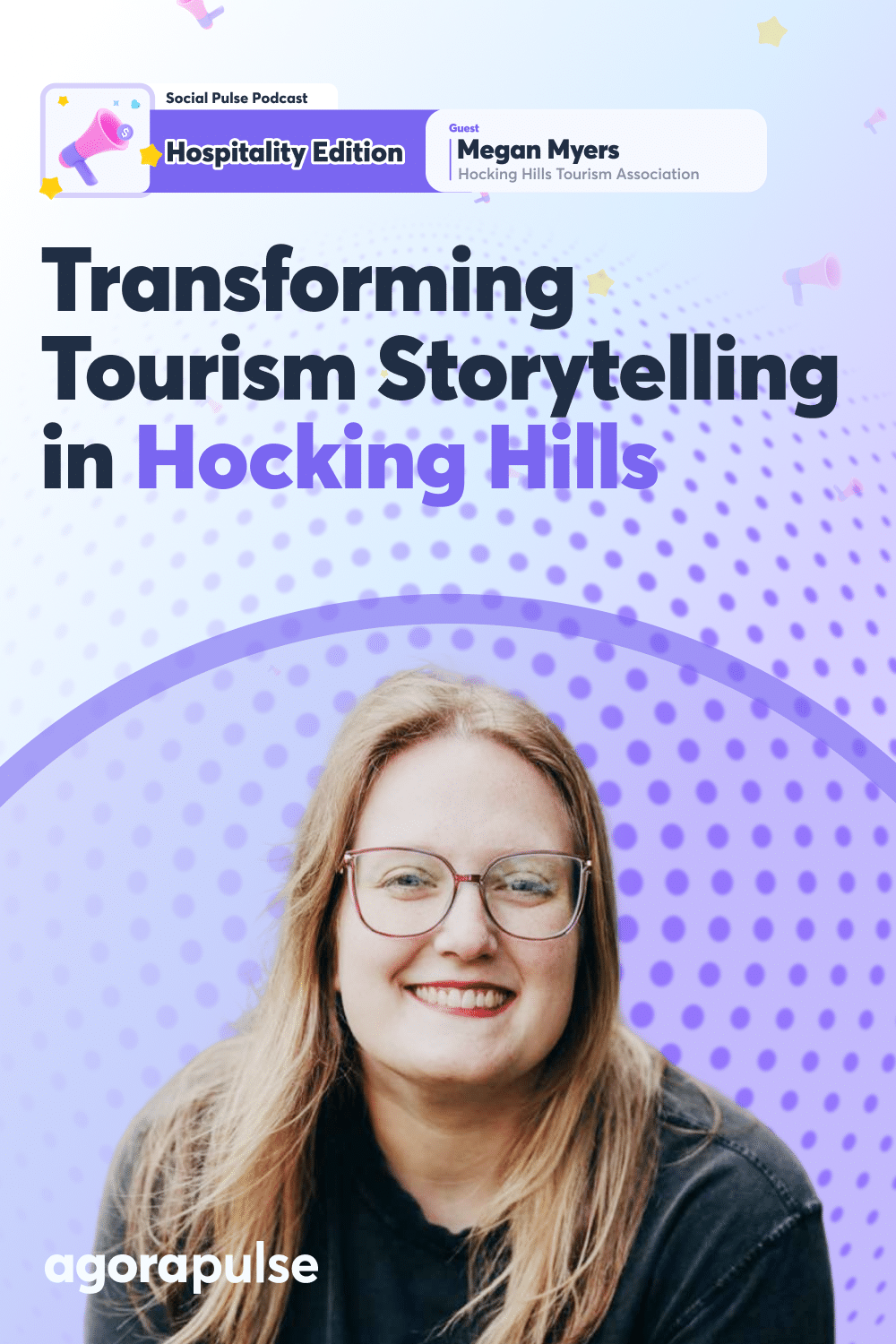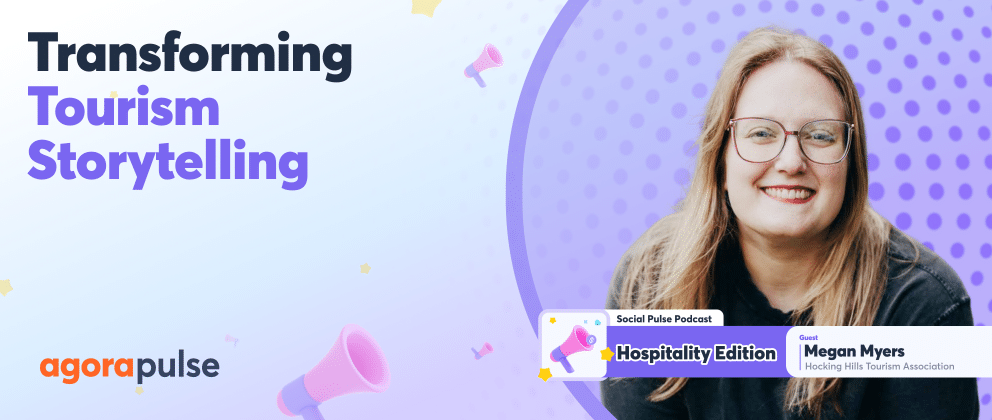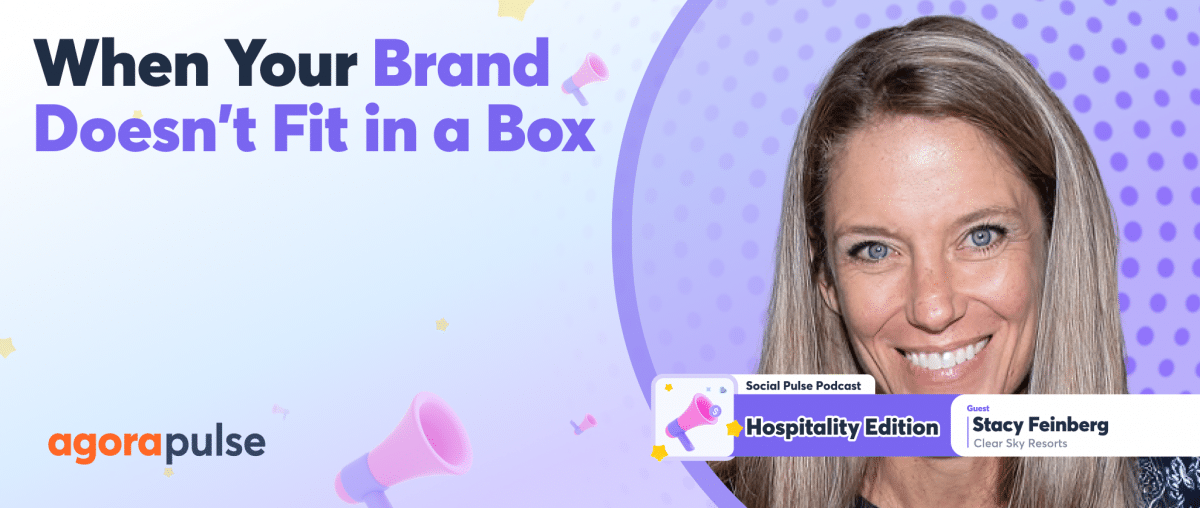Tourism marketers are constantly balancing the need to showcase breathtaking landscapes while measuring whether all those likes translate to visitors.
In this episode of Social Pulse: Hospitality Edition with Agorapulse’s Chief Storyteller Mike Allton, Megan Myers, digital media director for the Hocking Hills Tourism Association, tells how she has transformed how Southeast Ohio tells its story.
[Listen to the full episode below, or read along for the transcript of the Social Pulse: Hospitality Edition, powered by Agorapulse. Try it for free today.]
Tell us about the Hocking Hills Tourism Association’s marketing strategy before you came on board.
Megan Myers: Hocking Hills is a region in southeast Ohio.
Our biggest attraction is the Hocking Hills State Park, and as the tourism association of the area, we market the region.
When I first started back in 21, the strategy was primarily print, TV, and radio, and they also had a limited Facebook, Instagram and Twitter presence. They hadn’t had someone who was specifically dedicated to social media, so when they brought me on, that was the goal: to focus on the social media aspect and try to bring that in because it was gaining so much traction.
How did you know which social networks/channels would be the most effective?
Megan Myers: One of the biggest things is to think about who your audience is. Who are you trying to get to your destination?
For us, one of the main attractions is cabins. So you’re coming for a cabin stay, luxury lodging, tree houses, yurts, all of those kinds of things. Something we needed to be aware of is a lot of those lodging options don’t rent to people younger than 25, so we already knew our base was 25, and we wanted to go up from there. We also know that the weekends get filled with families, and younger people, we already knew that segment was being taken care of. So we wanted to focus on midweek, who can come midweek off-season.
You’re talking about a retired age group. “Mature and affluent” is what we say because we do have more expensive lodging options.
You have to focus on who your audience is. And then once you have your audience, then you can say which platforms are they using, and you can do that with the backend analytics.
So, on Meta, we were able to see Facebook was really good [at] engaging that particular audience, and Instagram was good at the bracket right below. So we’re talking about boomers and Gen X on Facebook and Instagram, Gen X and older millennials, and those are the groups that we’re trying to advertise to specifically. We realized that Twitter was not getting a lot of engagement, so I said, “Hey, let’s stop that. Let’s focus on Facebook and Instagram. Let’s put all of our effort behind those because I think that’s where we’re gonna see the most traction, the most click-throughs, and things like that.”
What is most effective for engaging these potential visitors on Facebook and Instagram?
Megan Myers: You have to think about the platforms as being separate because you can use the same content, you can tell the same story, but you have to do it in different ways on Facebook versus Instagram.
So, let’s say we want to tell a story about a business, such as one called Grandma Faye’s, which is a beloved business right near Old Man’s Cave, which is one of the main trails that people come to see. The way that we tell that story on Facebook is we have a Reel that goes through Grandma Faye’s and shows you what you’re going to see, and then in the post part, we’re going to tag Grandma Faye’s so people can go directly to their Facebook page. We can throw in a link that goes to explore Hocking Hills to the business listing. We can give people different areas to click through and see different things, but we want to get them directly to the information they’re seeking.
Nothing frustrates me as a consumer more than when you’re clicking on something and it’s taking you to information that’s not related to what you’re looking at. So, if we can make it as easy as possible for travelers, we’re also building a relationship with those travelers by saying, “Hey, if you click this link, it’s gonna take you to information that’s related, it’s not gonna take you on a wild goose chase across the website.”
That’s how we look at Facebook when you go to Instagram’s different audience, and you’re not necessarily going to have the ability to link to the direct businesses.
Because so many of our businesses are in Hocking County, the Hocking Hills region are mom-and-pop family-run businesses. They don’t have time to run a Facebook, an Instagram, and a website. So on Instagram, you might not be able to tag them directly so you have to be intentional and engaging in that Reel. You can see we’re using the same reel on each platform.
We have to think about how we’re getting people to learn more. So, you have to make your caption interesting enough. You have to make your Reel interesting enough that the consumer is going to take the time to do those extra clicks, to get to a link in your bio, to then take you to more information about Grandma Faye’s, for example.
How do you draw that line between showcasing what folks can do versus where they can go to buy and eat and so on?
Megan Myers: One of the things that I focused on this year—so it’s become a strategy for this year—is saying, “How can we take an itinerary and turn it into something engaging that’s gonna be on social media?”
So, when you do an itinerary, you can say, “Hey, first day, why don’t you start with a gorgeous hike at Ash Cave and then go check into your lodging and then go to dinner at Millstone Barbecue?”
By doing that, we can show these gorgeous landscapes as well as point out all of these businesses and activities you could do.
Day two: Why don’t you go horseback riding? And while you’re in that area, you could go to this other restaurant and ping pong people around to the different places. And it’s nice for them because it might be their first visit. So if you can say, you like these kinds of activities, you can do this itinerary. If you like these kinds of activities, you can do a different one.
One of the things that we have been doing on that front is on our website. We have an itineraries page, and I go through and try to add to it regularly, but we have one for active retirees. We have one for families with kids ages, six to 12 bachelorette parties, and different things like that.
So once you have a base content—a base piece of creative that lives on your website—then you can go in with photos, you can do reels, and take what’s just on paper on your website and give it a live show. This is what a teaser of the trail looks like, and if you go horseback riding, here’s what it looks like and you can get excited about the different activities and the different restaurants. So, it pulls all of it together.
That’s the way I found to be the most engaging in showing the different aspects of the area and the different things people can do by guiding them through a story of this is what you could be doing when you come here.
I think that’s the best way I’ve been able to find to tell the story of nature plus the businesses that we want to promote in the area. So our membership.
Related episode: Tourism Marketing Unplugged: Real Challenges, Real Solutions with Kevin Furst from the Poconos Mountain Visitors Bureau
What’s been your approach to growing your newsletter audience?
Megan Myers: I am very passionate about my newsletters.
When I started we had just over 40,000 subscribers and we’re well over the 60K mark. At this point, I boil it down to you don’t want to waste people’s time, and you don’t want to be spamming them. You don’t wanna send so many newsletters that they’re just like, “Ugh, here’s another newsletter.”
I keep it simple.
I have it set up to where you’re gonna have new content each month. It’s a monthly newsletter, so just one and done it on that. You’ll have the new content like I talked about, that lives on your website, so you’re driving traffic to your website once you’re on that content. So say an itinerary like we just talked about. We have an itinerary for active retirees. Maybe they want to go see Cedar Falls and on that itinerary, I can link them to different places on the website. So I’m using just one itinerary on the newsletter, but once they’re in on the website, I can link them to more information.
But as I said earlier, you wanna make sure you’re not sending them on a wild goose chase but allowing them to look through the website in a guided way. That helps with the click-through rates. So we want to give them two to three quality pieces of content to look at. One itinerary, one ultimate guide. I have an ultimate winter guide, spring guide, and things like that.
So they’re getting an overview of what’s happening in the area. And then I say two to three events. So pick two to three popular, really well-attended, things that people get excited about. So the Bigfoot Festival or the annual winter hike, things like that. Seasonal, of course, things that you are coming up with.
If you can keep it to, I would say, six max blocks of things that they can read through and focus on quality over quantity. I found that honing that approach gets people more engaged and opening those newsletters. Then something else that I didn’t think of, but the digital agency we work with told me, and I have found it to be true, is that when you add an emoji to your email subject line, people get more engaged with that.
They see it, it’s friendly, it’s personable, and I found that too, to work as well. So keep it simple. Highlight important things that people are going to be interested in. And then once you guide them to those pages, make sure you’re providing more information, hyperlink out to other parts of your website.
On the backend, you can see how much time they’re spending on-site. So if you have a blog or an itinerary and you see people like information about lodging, maybe next month. You highlight that, you put it right at the top, more information about lodging, and you can follow the month by what people are.
That’s what I found to be successful.
How do you prioritize digital initiatives to help your strategy when you know you can’t do everything?
Megan Myers: One of the biggest things is I use a scheduling tool so I can be working in advance if I have, two hours I can do one day, but I know I have a bunch of meetings the next day. I can get things scheduled in advance.
The other thing is focusing in, like I said, when I came, they had four platforms they were working across, and I honed that down to the ones that we’re seeing the highest ROIs on: Instagram and Facebook.
Something that I’ve been told by the digital agency that we work with is the algorithms’ reward consistency. So whereas this is my full-time job, I can post daily, not everyone can, but if you can post consistently three times a week on the same day, then the algorithm rewards that versus sporadically.
The other thing is I do have the ability to work with an agency that I provide the creative, they manage the ad side of it, and then something that recently I’ve been able to do and I found that was almost a necessity, is hired someone that can, their exclusive role is I say, Hey, I need these four videos this week, and he goes and makes the Reels. And I know that’s not attainable for every organization, but keeping up with the algorithm rewards Reels. It rewards that video.
So those are the three things that I have found most helpful for me at our organization.
Tell us about partnering with Ohio’s State Tourism co-op program
Megan Myers: The state co-op has been happening for many years. It’s gone through different evolutions, but what we’ve found is when you can rally behind the tourism association of the state, then people are coming to Ohio. They’re seeing Ohio as a destination. You can go up north and have beaches. You can come down southeast and have the Appalachian foothills. You can go to one of the three Cs, Cleveland, Columbus, or Cincinnati, and have the city experience.
So we like to say, “Rising tides lift all boats.” If we can all pull together and tell a compelling story as to why someone should come to Ohio, we can point them around to different places, and show off the different types of entertainment and different types of destinations that we have within the state, it gets people excited.
We can all pull together by working through that co-op.
“Rising tides lift all boats.”
How do you currently measure the success of your social media?
Megan Myers: It can definitely be difficult because we’re a member-based organization.
Our job is to promote our members. It is to promote the area. We are a destination marketing organization. So we’re not trying to promote Hocking Hills Tourism Association, we’re trying to promote the region. That said, we do need to get people into the Explore Hocking Hills pages to then be able to see the analytics of that site to be able to promote them.
So, we do keep a close eye on analytics. And I’ll say specifically, ’cause I know analytics is a huge topic, we pay attention to click rates and pay attention to the amount of time someone’s looking at something. So whether that’s a video, whether that’s a specific page on our website, we pay attention to the general engagement rates, which I don’t find to be the most helpful day-to-day, but it is a good benchmark to pay attention to.
And then also pay attention to what kind of content is performing the best. How many people are liking, how many people are sharing, commenting? If you can get more engagement, more shares, more comments, and more people talking about it, then you know you’re working on the right track.
What resources or tools help you stay current with all marketing trends, particularly in the tourism industry?
Megan Myers: I have found that it’s super-helpful to attend a couple of conferences a year. One that I go to every year is the Destinations International Annual Convention and Destinations International puts out a lot of information weekly about the different trends, and different things that are happening within the tourism industry.
So keeping connected with the people that’s their job. Their job is to tell us the big picture and help guide us through some of these things. Paying attention to that is helpful and then see what tools you’re using and see what they’re putting out.
One tool that I use is called CrowdRiff, and it helps pull in user-generated content. So what are people posting on Instagram organically? And then you can ask permission to use those photos and things like that. But they put out a bunch of information on trends that they’re seeing from their side.
So just keep aware of what other people are putting out, like hone in on the ones that you find most useful.
But to start, you just have to sign up for some newsletters, go do some digging, and then see what resonates with you for your specific role. This is what I have found to be the most helpful.
Thank all of you for reading the highlights of this episode with Megan Myers. Don’t forget to find the Social Pulse Podcast: Hospitality Edition on Apple, and drop us a review. We’d love to know what you think. Don’t miss other editions of the Social Pulse Podcast like the Retail Edition, Agency Edition, and B2B Edition.





